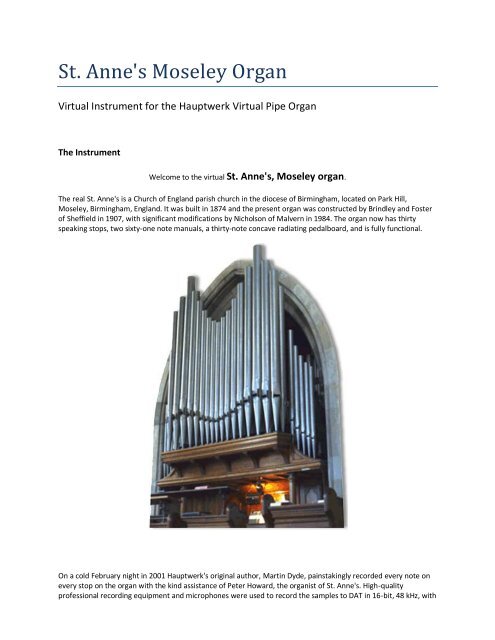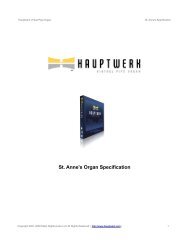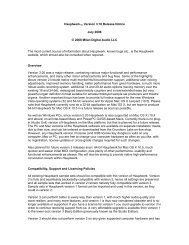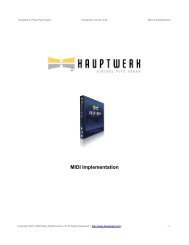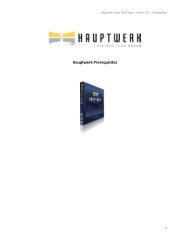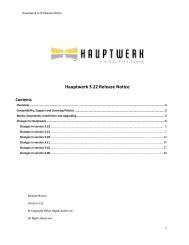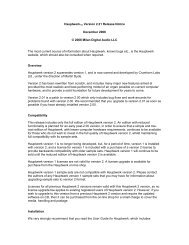St. Anne's Moseley Organ Information - Hauptwerk
St. Anne's Moseley Organ Information - Hauptwerk
St. Anne's Moseley Organ Information - Hauptwerk
Create successful ePaper yourself
Turn your PDF publications into a flip-book with our unique Google optimized e-Paper software.
<strong>St</strong>. <strong>Anne's</strong> <strong>Moseley</strong> <strong>Organ</strong>Virtual Instrument for the <strong>Hauptwerk</strong> Virtual Pipe <strong>Organ</strong>The InstrumentWelcome to the virtual <strong>St</strong>. <strong>Anne's</strong>, <strong>Moseley</strong> organ.The real <strong>St</strong>. <strong>Anne's</strong> is a Church of England parish church in the diocese of Birmingham, located on Park Hill,<strong>Moseley</strong>, Birmingham, England. It was built in 1874 and the present organ was constructed by Brindley and Fosterof Sheffield in 1907, with significant modifications by Nicholson of Malvern in 1984. The organ now has thirtyspeaking stops, two sixty-one note manuals, a thirty-note concave radiating pedalboard, and is fully functional.On a cold February night in 2001 <strong>Hauptwerk</strong>'s original author, Martin Dyde, painstakingly recorded every note onevery stop on the organ with the kind assistance of Peter Howard, the organist of <strong>St</strong>. <strong>Anne's</strong>. High-qualityprofessional recording equipment and microphones were used to record the samples to DAT in 16-bit, 48 kHz, with
each note recorded being about 3-7 seconds in length.Over the following nine months the samples were mixed down into mono at 16-bit, 44.1 kHz (CD quality) toproduce a sample set for <strong>Hauptwerk</strong> version 1 that would have a relatively modest memory requirement, editedand processed with noise reduction. Due to the rather haphazard tuning of the instrument, the whole sample setwas re-tuned to A-440 concert pitch and equal temperament. Samples from defective pipes were re-created fromtheir neighbors where necessary, and moderate regulation and voicing discrepancies were corrected digitally.However, the intention was to maintain the character and integrity of the original instrument, with minimalmodifications and corrections being made.Following several more recording sessions in 2004 and 2005, for <strong>Hauptwerk</strong> version 2 and above we revised thewhole sample set, with a new photo-realistic console and models of the acoustic effects of the swell box,tremulants, effects of the wind supply system, multi-looped samples and much more. All models were based ondetailed analysis of recordings and measurements made from the real instrument. We kept the samples in theiroriginal mono format since <strong>Hauptwerk</strong> can pan them into stereo in real-time.Special thanks to Reiner Suikat of Pipeloops for assistance in the preparation of the sample set. You can also readmore about both on the <strong>St</strong>. <strong>Anne's</strong>, <strong>Moseley</strong> Church website.
A brief tour of <strong>St</strong>. <strong>Anne's</strong>The church was built as a daughter church of the larger <strong>St</strong>. Mary's, <strong>Moseley</strong>, and was completed and consecratedin 1874. It was paid for by Rebecca Anderton, and built upon land donated by W. F. Taylor. Mainly stone, its designby Frederick Preedy is of a basic gothic style.The exterior in winter:The nave:The altar, east window and organ:
The <strong>Organ</strong> SpecificationThe organ of <strong>St</strong>. <strong>Anne's</strong>, <strong>Moseley</strong>, Birmingham, England, is a 1907 two-manual Brindley and Foster instrument withthe following specification:SWELL:PEDAL:Lieblich Bourdon 16' (wood, Brindley).Geigen Principal 8' (metal, Brindley).Salicet 4' (metal, Brindley).Rohr Flute 8' (wood, Brindley).Flauto Magico 4' (wood, Brindley).Gamba 8' (metal, Brindley).Voix Celeste 8' (metal, Brindley).Piccolo 2' (metal, Brindley).Mixture III ranks (metal, Nicholson).Clarinet 8' (metal, Nicholson).Trumpet 8' (metal, Nicholson).Oboe 8' (metal, Nicholson).Contra Fagotto 16' (metal, Brindley and Nicholson).TremulantOpen Diapason 16' (wood, Brindley and Schultz).Echo Bass 16 (wood, Brindley).Sub-Bass 16' (wood, Brindley).Principal 8' (wood and metal, Schultz and Nicholson).Bass Flute 8' (wood, Brindley).Fifteenth 4' (metal, Nicholson).Trombone 16' (metal, Nicholson).GREAT:COUPLERS:ACCESSORIES:Open Diapason Large 8' (metal, Brindley).Open Diapason Small 8' (metal, Lewis).Dulciana 8' (metal, Lewis).Lieblich Gedact 8' (wood, Lewis).Principal 4' (metal, Lewis).Clear Flute 4' (metal, Brindley).Fifteenth 2' (metal, Brindley).Mixture IV ranks (metal, Nicholson).Trumpet 8' (metal, Nicholson).Clarion 4' (metal, Nicholson).Swell Octave.Swell Sub-Octave.Swell Unison Off.Swell to Great.Swell to Pedal.Great to Pedal.Swell Octave to Great.Swell Sub-Octave to Great.Great and Pedal Pistons Coupled.The following have been added for the <strong>Hauptwerk</strong> virtualmodel of the instrument:ACCESSORIES:40-stage Crescendo, adjustable.General Cancel.Setter piston.FF piston, adjustable.PP piston, adjustable.5 Thumb pistons to Swell, adjustable.5 Thumb pistons to Great, adjustable.Reversible Swell to Great.Reversible Great to Pedal.5 Toe pedals to Swell, adjustable.Reversible Toe pedal Great to Pedal.Balanced Swell pedal.COUPLERS:Swell to Great Melody.Pedal to Great Bass.Crescendo on Swell.Crescendo on Great.Crescendo on Pedal.
A tour of the organThe first organ in <strong>St</strong>. <strong>Anne's</strong> was a small chamber by the respected firm of J. C. Lewis of London, whose pipeworkwas later incorporated into the current instrument.The current instrument was commissioned from Brindley & Foster of Sheffield in 1906 by the Rev. John HattonJones and completed in 1907; a two-manual and pedal instrument with pneumatic action and manual crankoperatedblowing.An electric blower was installed in 1921 and the pneumatic action on the manual divisions replaced by Harris ofBirmingham after wartime bomb damage in 1940. Some cleaning and re-regulation was undertaken in 1954, andagain in 1969, the latter by Nicholson & Co. of Malven and including some tonal re-design and additional pipework.Electric actions replaced the electro-pneumatic in 1984, and the combination action was made adjustable by thepictured switchboard, along with various other maintenance and improvements to the console, again byNicholson. In 1989 Nicholson replaced the original Brindley & Foster slider-less chests with electric slider chestsand several additional reed ranks were installed.The main facade:
The manuals and thumb pistons:The Swell stop jamb on the left of the console:
The Great and Pedal jamb on the right:The combination programming switch board:The main part of the console:
The pedals, swell pedal and toe pistons:The console from the choir:The side of the organ chamber:
The Great Large Open pipework at the front of the organ:The Great wind-chest:
Some of the Pedal pipework at the side of the organ chamber:


